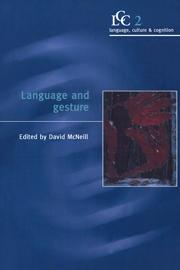Book contents
- Frontmatter
- Contents
- Acknowledgments
- Introduction
- Part 1 Gesture in action
- Part 2 Gesture in thought
- 7 Growth points in thinking-for-speaking
- 8 How representational gestures help speaking
- 9 Where do most spontaneous representational gestures actually occur with respect to speech?
- 10 Gesture production during stuttered speech: insights into the nature of gesture–speech integration
- 11 The role of gestures and other graded language forms in the grounding of reference in perception
- 12 Gesture and the transition from one- to two-word speech: when hand and mouth come together
- Part 3 Modeling gesture performance
- Part 4 From gesture to sign
- Index
9 - Where do most spontaneous representational gestures actually occur with respect to speech?
Published online by Cambridge University Press: 07 January 2010
- Frontmatter
- Contents
- Acknowledgments
- Introduction
- Part 1 Gesture in action
- Part 2 Gesture in thought
- 7 Growth points in thinking-for-speaking
- 8 How representational gestures help speaking
- 9 Where do most spontaneous representational gestures actually occur with respect to speech?
- 10 Gesture production during stuttered speech: insights into the nature of gesture–speech integration
- 11 The role of gestures and other graded language forms in the grounding of reference in perception
- 12 Gesture and the transition from one- to two-word speech: when hand and mouth come together
- Part 3 Modeling gesture performance
- Part 4 From gesture to sign
- Index
Summary
Introduction
Speech-accompanying spontaneous gestures have attracted the attention of psycholinguists and cognitive psychologists in recent years. Theorists assert that spontaneous gestures, along with the speech they accompany, are a window into the nature of speakers' mental representations and processes (Goldin-Meadow et al. 1993; Kendon 1986; McNeill 1985, 1987, 1992). Researchers have shown that speech-accompanying gestures are inextricably intertwined temporally and semantically with speech (Kendon 1980; McNeill 1992). Various models of production of speech and representational gestures (i.e., iconics, metaphorics, and abstract deictics) have been presented (Beattie & Aboudan 1994; Butterworth & Hadar 1989; Kita 1993; Krauss et al. 1996; McNeill 1989, 1992; Nobe 1993, 1996).
There have recently been debates on the credibility of each model (see Hadar & Butterworth 1997; Hadar & Yadlin-Gedassy 1994; Hadar et al. 1998; and other chapters in this book). Unfortunately, the current chapter does not have any space (and thus it is not the writer's intention) to evaluate all models mentioned above. It is, however, a fact that many agree that the temporal relationship of representational gestures and speech is very significant in constructing gesture- and speech-production models. Moreover, the ‘tendency’ of gestures to occur with respect to their accompanied speech does matter. This chapter reports on how the timing between gestures and speech is measured, and how this gesture tendency is calculated and presented as evidence for the construction of speech and gesture models.
Comprehensive models of speech and gesture should account for as many gestures as possible. If the number of gestures which are accounted for by a model is rather small, we should not regard it as a general theory (Nobe 1996).
- Type
- Chapter
- Information
- Language and Gesture , pp. 186 - 198Publisher: Cambridge University PressPrint publication year: 2000
- 41
- Cited by

